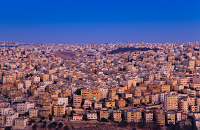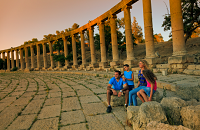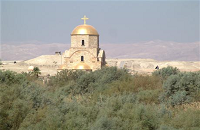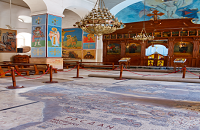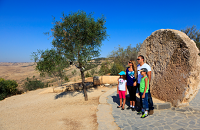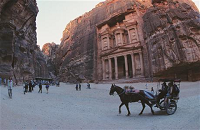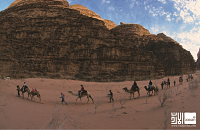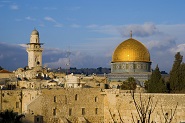
[Y]our trip to the Middle East isn’t really complete without visiting the Holy Land. The extraordinary city of Jerusalem is the focal point of any trip to the Holy Land and is the base for exploring the country. You can fly directly into Tel Aviv Ben Gurion airport, from where there is a rail service to Jerusalem that takes about two and a half hours. But if you are combining it with a trip to Jordan you are likely to use the Allenby Bridge crossing from Jordan into Israel. The crossing is not without the usual difficulties encountered when exiting one country and entering another and is a fascinating process which should be regarded as part of the travel experience. The heightened security in place for anyone entering Israel means that the whole process can take in excess of two hours.
[B]ut once you reach Jerusalem, any inconvenience you might have encountered in getting there is quickly forgotten. The city is full of good hotels to suit all budgets and there are many we can recommend. The recently refurbished St. George Landmark Hotel in the Old City of Jerusalem makes an ideal base from which to visit the many inspiring sites that the city has to offer.
[J]erusalem is a religious nucleus for Jews, Christians and Armenians as well as being the third most sacred city in Islam. The city, resting on the original hills of the City of David and surrounded by a wall over four kilometers long with seven gates, 34 towers, and a citadel (the Tower of David), is divided into four residential quarters.
-
The Moslem Quarter
[T]his is the largest quarter in the old city and one of the starting points for a visit there is Temple Mount, site of the Dome of the Rock and the Al-Aqsa Mosque. The shining Dome of the Rock was built over a sacred stone as a shrine for pilgrims. It is octagonal in shape with 60 feet high outer walls and a golden dome that is a city landmark.
[T]he Al-Aqsa Mosque, which was rebuilt in 1035 and has had several restorations since then, is part of a complex of religious buildings in Jerusalem known as either the Majed Mount or Al-Haram ash-Sharif (the Noble Sanctuary) to Muslims and the Temple Mount to Jews. The Al-Aqsa Mosque is the largest mosque in Jerusalem where around 5,000 people can worship inside and outside the mosque. It is a mixture of architectural styles including some from when the Crusaders held Jerusalem. During that time the mosque was used as a palace and called the Temple of Solomon, in the belief that it was built on the site of the original temple.
-
The Armenian Quarter
[T]he Armenian quarter is the smallest quarter of the Old City. The Armenians settled in Jerusalem in the 4th century AD and the St. James Cathedral was built in the 12th century. This church later became the center for the Armenian people in Israel. It is one of the most beautiful churches in the country and is built upon the remains of a Byzantine church. At the centre of the church is a dome resting on four pillars, through which the sun shines and sheds light on the beautiful wall paintings. There is also a seminary for Armenian priests and the Armenian Museum, which presents the cultural and national history of the Armenian people. The quarter also houses the Armenian Patriarchate, a building of major importance to Armenians.
-
The Christian Quarter
[T]here are more than 40 churches, monasteries and hostels that were built for Christian pilgrims in this quarter, in the heart of which stands the Church of the Holy Sepulchre or the Church of the Resurrection. This, according to Christian tradition, was the site on which Jesus was crucified and buried following his final walk along the Via Dolorosa, or the Stations of the Cross. The Via Dolorosa begins at the courthouse, which was located at what is now the Lions’ Gate and ends at Calvary Hill where the Church is now located. There are several sites that are important to the Christian tradition inside the Church of the Resurrection, including the Stone of Anointing, the tomb, and the rotunda.
[T]he market, one of Jerusalem’s most popular tourist attractions, is located in the Christian quarter and is a noisy, colorful area where you can buy decorated pottery, candles, souvenirs, ethnic costumes, mats, rugs, beads, jewelry, glass lamps and decorative items. The merchants call out their wares and the food stands emit tantalizing aromas. One of the fun things about this market is that you are expected to bargain for the goods and if you are persistent enough, you can bargain shopkeepers down from their original price.
-
The Jewish Quarter
[T]he Jewish quarter is the main residential area for Jews in the old City. This quarter also contains the Western Wall, or the Wailing Wall, which is a holy place for the Jews as it was part of the Temple and close to the Holy of Holies within the Temple. The Jewish quarter also contains interesting archaeological sites such as the Burnt House, which are the remains of a house from the time of the destruction of Jerusalem by the Romans 2000 years ago. There is also the Cardo, which is a typical Roman street built in the 6th century and consists of stores situated between two rows of columns. You can still see the remains of the tall columns, arches and stone floor in the Cardo.
-
Jerusalem
[E]ast of the Old City is the Mount of Olives from where you get a great panoramic view over the city. It is also where there are other important Christian sites with several churches, including three Churches of the Ascension and Abraham’s Monastery. Apart from the holy places throughout the Old City, there are several charming sites that are well worth visiting. One example is a promenade along the tops of the walls from where you can look out over the Old City and the New City. These tours along the walls are also available as a night-time experience when the city’s lights sparkle and create an unforgettable fairytale vista to complete your visit to this very special city.

